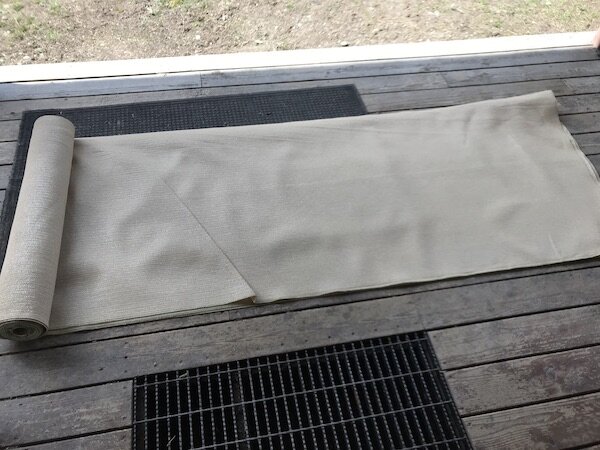Light
I make it to about the middle of April every year and have to take the insulated curtains down off the windows. By that point, I cannot stand living in a cave any longer and my desire for sunlight overrides any savings we might get on our heating bill. Of course, taking down the curtains means I can see exactly how badly the living room needs to be cleaned, so that’s what I’ll be doing today.
I took the insulated curtain off the window in the laundry room, too. That room is considerably brighter now because we lost so many trees in the woods.
And while I am taking curtains off some windows, I am getting ready to make a sunshade for the porch. Some places don’t have enough light and some places have too much:
My college friend, Scott, who lives in Ohio, generously gifted me the Coolaroo mesh fabric left over from a shade he made for a pergola at his house. We have a glider rocker on the porch where the husband and I like to sit and debrief when he gets home from work. Unfortunately, by that time of day, the sun is low enough in the sky that it beats down on that section of the porch. I priced out sunshades—Wayfair has one, but it’s $600.
Unrolled, the fabric Scott sent me is 12’ wide from selvedge to selvedge. I need a piece 11-1/2’ wide and about 8’ long. My thought is to hem the sides to make the piece the proper width, then turn under a 3” hem at the top and install grommets every couple of inches. The husband can put hooks on the porch framing from which to hang the shade. I’ll hem the bottom to an appropriate length. It won’t be as fancy as the Wayfair shade—I don’t plan to install any hardware so it can be raised or lowered—but it will work for what we need.
I am going to take the fabric out to the new shop, which has plenty of room for me to lay it out for cutting. And I am pretty sure I can run up the hems on the Necchi industrial. Scott sewed his sunshade on a vintage Singer 15-91.
***********************************************************
I am not feeling overly anxious these days, although I know many people are. However, the unexpected shortage of chicks led me to worry about getting piglets. The one saving grace is that it is a lot harder to go from 0 to 60 on pig production than it is for egg production, so fewer people are going to try pigs for the first time this year. However, the supplier we used to use tended to over-promise and under-deliver and finally stopped selling pigs altogether. We didn’t do pigs last year for that reason, and I knew we needed to find a replacement supplier. We’re sort of competing with the 4-H kids, who in recent years have switched from the old standby Chester Whites to the heritage breeds like Durocs and Berkshires, which are what we get. The kids have to have their pigs finished out by the fair in August and we don’t send ours for processing until October, so we can wait a few weeks for later litters.
Cathy gave me the name of a woman she knows who raises pigs. I called yesterday and was able to reserve six piglets for delivery at the beginning of June. She is getting bred sows from a Hutterite colony east of the mountains. These will either be York/Duroc crosses or Landrace/Duroc crosses, either of which is fine with us. We’ll keep a couple for ourselves and sell the others.
We missed having pigs last year. It will be good to have them on pasture again.
When we first started raising chickens and pigs, I followed the Chicken Thistle Farm CoopCast. (The back episodes are chock full of great information and still worth a listen even though they go back several years.) It was produced by a young couple in western New York. Farming was not their primary source of income, though, and it took so much time that they got a bit burnt out. Their listening audience was devastated when they stopped podcasting. A few months ago, Andy—the husband half of the duo—started dropping hints that something new was coming, and last week, he posted a couple of videos on their YouTube channel.
This one in particular was interesting, because he talks about economies of scale and how it’s easier to scale up than scale down, at least where animals are concerned.
The husband concurs, and says that the difference between raising four pigs and six pigs is negligible. We won’t breed our own pigs, though. We don’t have adequate winter shelter for them, for one thing, and the task of doing the artificial insemination would fall to yours truly. I could do it, but I’m not excited about the idea. I do much better with plants than animals, honestly. (The first batch of eggs is in the incubator.)
***********************************************************
I finished quilting the most recent Candy Coated quilt yesterday morning and attached the binding. Now I just have to sew the binding down, which is a good evening activity when I want to sit for a bit. I’m not sure what sewing project is up next, but I always have masks to work on.

